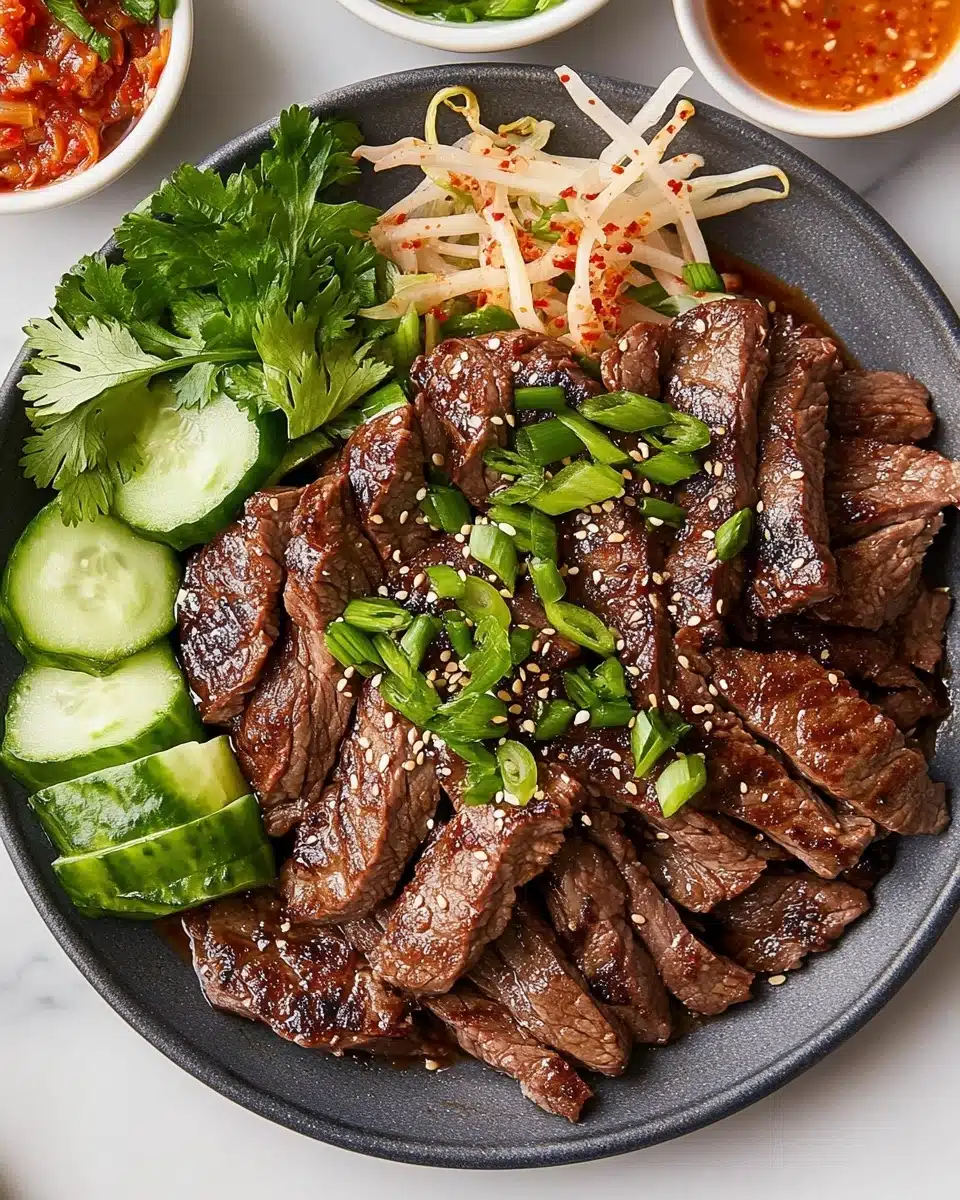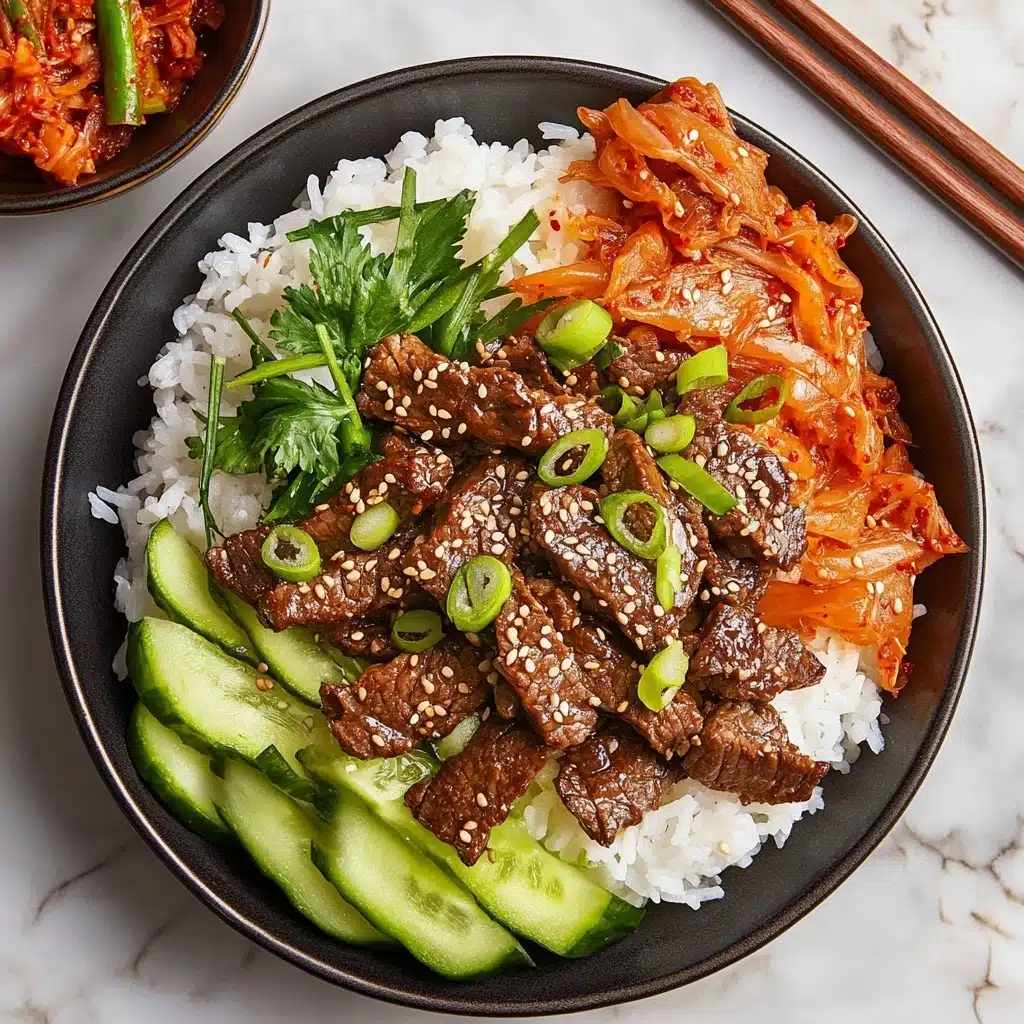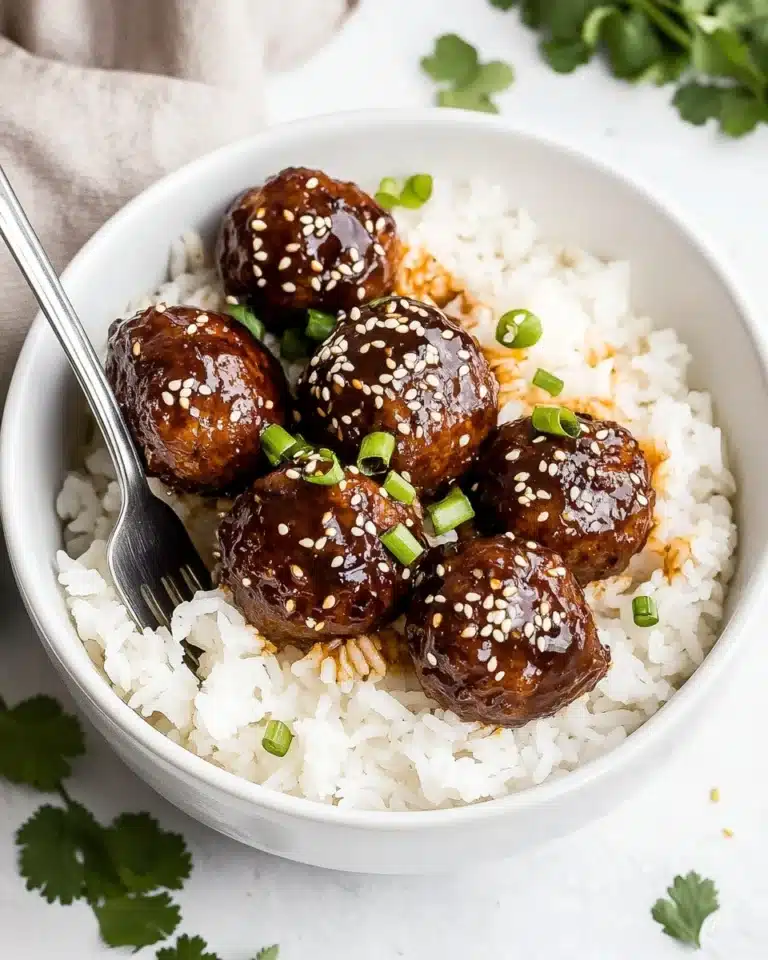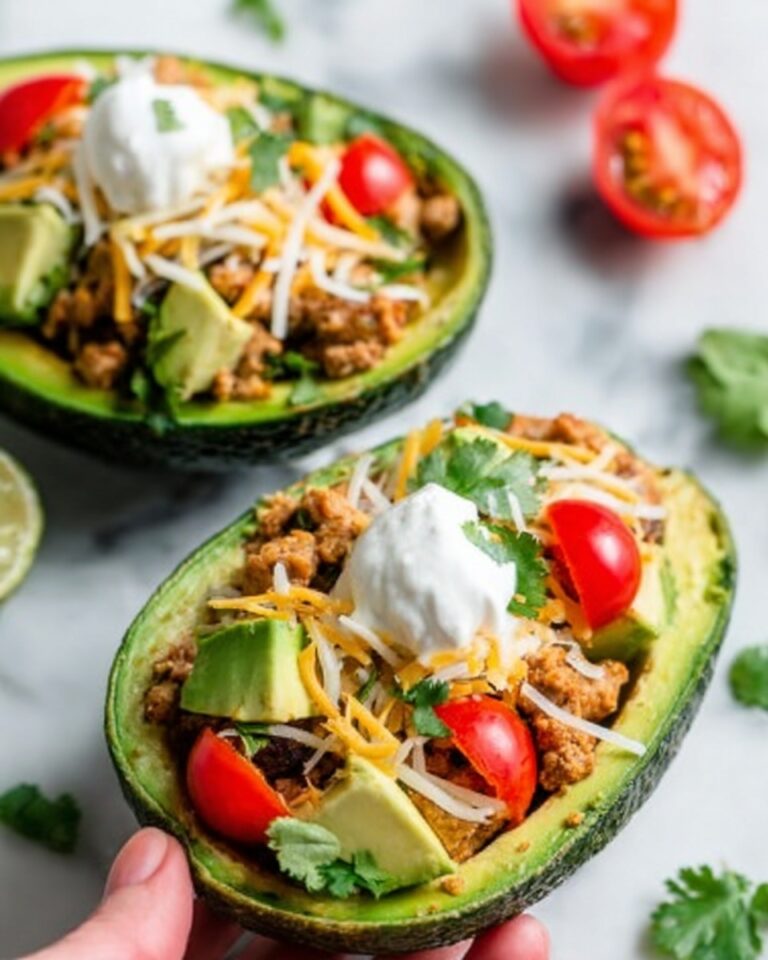If you’ve ever longed for something deeply flavorful, tender, and just a little bit crave-worthy, let me introduce you to my all-time favorite: Korean Beef Bulgogi. This classic dish of marinated, quick-grilled beef bursts with sweet, savory, and spicy notes, making it absolutely irresistible whether served over rice, wrapped in lettuce, or even tucked into a weeknight rice bowl.
Why You’ll Love This Recipe
- Incredible Flavor Harmony: Every bite of this bulgogi is a masterclass in sweet, savory, garlicky deliciousness, with subtle heat from gochujang and bursts of aromatic sesame.
- Tender, Melt-in-Your-Mouth Beef: The quick marinade works magic, infusing the steak with flavor and keeping it juicy and oh-so-soft.
- Surprisingly Easy & Fast: With a handful of pantry staples and just a few steps, you can whip up this impressive dish in less time than you’d think.
- Crowd Pleaser: Whether you’re feeding family or wowing friends, Korean Beef Bulgogi always disappears fast from the table—guaranteed!
Ingredients You’ll Need
The magical thing about Korean Beef Bulgogi is how it shines with a small group of powerhouse ingredients. Each one plays a crucial role: building the marinade’s depth, creating that signature tenderness, and bringing pops of color that make this dish a feast for the eyes as well as your taste buds.
- Boneless Rib Eye Steak: Opt for well-marbled rib eye for maximum tenderness and that classic bulgogi bite.
- Pear (½ small, peeled and grated): Traditional and important—it gently sweetens and tenderizes the beef; use Asian pear if you can find it, but a ripe Bosc or Bartlett works beautifully too.
- Reduced Sodium Soy Sauce: Brings savory, umami backbone while balancing out the marinade’s sweetness.
- Brown Sugar: Rounds out the soy sauce with a rich, caramel sweetness that’s key to sticky, glossy goodness.
- Toasted Sesame Oil: Aromatic and nutty, this really makes the flavor pop—don’t skip it!
- Garlic (minced): Classic Korean flavor—you’ll definitely taste the difference from fresh garlic here.
- Freshly Grated Ginger: An essential zing that keeps the flavors lively.
- Gochujang (Korean red pepper paste): A little goes a long way! Adds umami, gentle heat, and gorgeous color.
- Vegetable Oil (divided): For searing—use a neutral oil with a high smoke point so the beef chars instead of steams.
- Green Onions (thinly sliced): For that signature fresh, crisp finishing touch.
- Toasted Sesame Seeds: A sprinkle at the end for extra texture and nutty aroma.
Variations
One of the best things about Korean Beef Bulgogi is how forgiving and customizable it is—no need to stress if you’re missing an ingredient or want to tailor it to your tastes. Here are creative ways to put your unique spin on this classic!
- Chicken or Pork Bulgogi: Swap the beef for thin-sliced chicken thigh or pork shoulder for a lighter or different twist—just adjust cook time a little.
- Extra Heat: Add sliced fresh chilies or a drizzle of chili oil to amp up the spice, perfect for anyone who loves a fiery kick with their bulgogi!
- Low-Sugar Option: Replace brown sugar with honey, maple syrup, or a sugar substitute to suit your dietary needs or preferences.
- Vegetarian Bulgogi: Try marinating portobello mushrooms or tofu—trust me, the marinade is just as magical and satisfying on veggies!
How to Make Korean Beef Bulgogi
Step 1: Prepare and Slice the Beef
For that irresistible restaurant texture, tightly wrap your rib eye steak in plastic wrap and pop it in the freezer for 30 minutes. This slightly firms up the meat, so you can slice it wafer-thin—across the grain—into neat, ¼-inch strips. Trust me, this trick is a total game-changer for tenderness!
Step 2: Mix the Marinade and Marinate
In a medium bowl, whisk together the grated pear, soy sauce, brown sugar, sesame oil, garlic, ginger, and gochujang until combined. Add the sliced beef and the marinade to a large Ziploc bag, seal tightly, and gently massage to coat every strip. Chill for at least two hours—or overnight for maximum flavor depth—turning the bag occasionally so everything marinates evenly.
Step 3: Fire Up the Grill Pan
Heat 1 tablespoon of vegetable oil in a cast iron grill pan over medium-high. Working in batches for the best sear, add the marinated beef in a single layer. Cook, flipping once, until it’s gorgeously charred and caramelized—about 2-3 minutes per side. Repeat with remaining oil and beef, savoring that sizzle and aroma!
Step 4: Garnish and Serve
Transfer the sizzling bulgogi to a serving platter and shower it with sliced green onions and toasted sesame seeds. Serve immediately, and watch as everyone’s eyes widen at the first taste of this flavor-packed Korean classic!
Pro Tips for Making Korean Beef Bulgogi
- Slice Against the Grain: Always slice your steak across the grain—this breaks up muscle fibers and ensures unbelievably tender bites every time.
- Go for Overnight Marinade: If you have the time, give your beef a full night in the marinade; the flavors deepen and the texture becomes even silkier.
- Hot & Fast Cooking: Cook your bulgogi on a very hot pan in quick batches—this prevents steaming and gives you those coveted, caramelized charred edges.
- Pear Power: Use an Asian pear if possible for its delicate sweetness and natural tenderizing magic, but don’t sweat it if all you have is a regular ripe pear—it still works wonders!
How to Serve Korean Beef Bulgogi
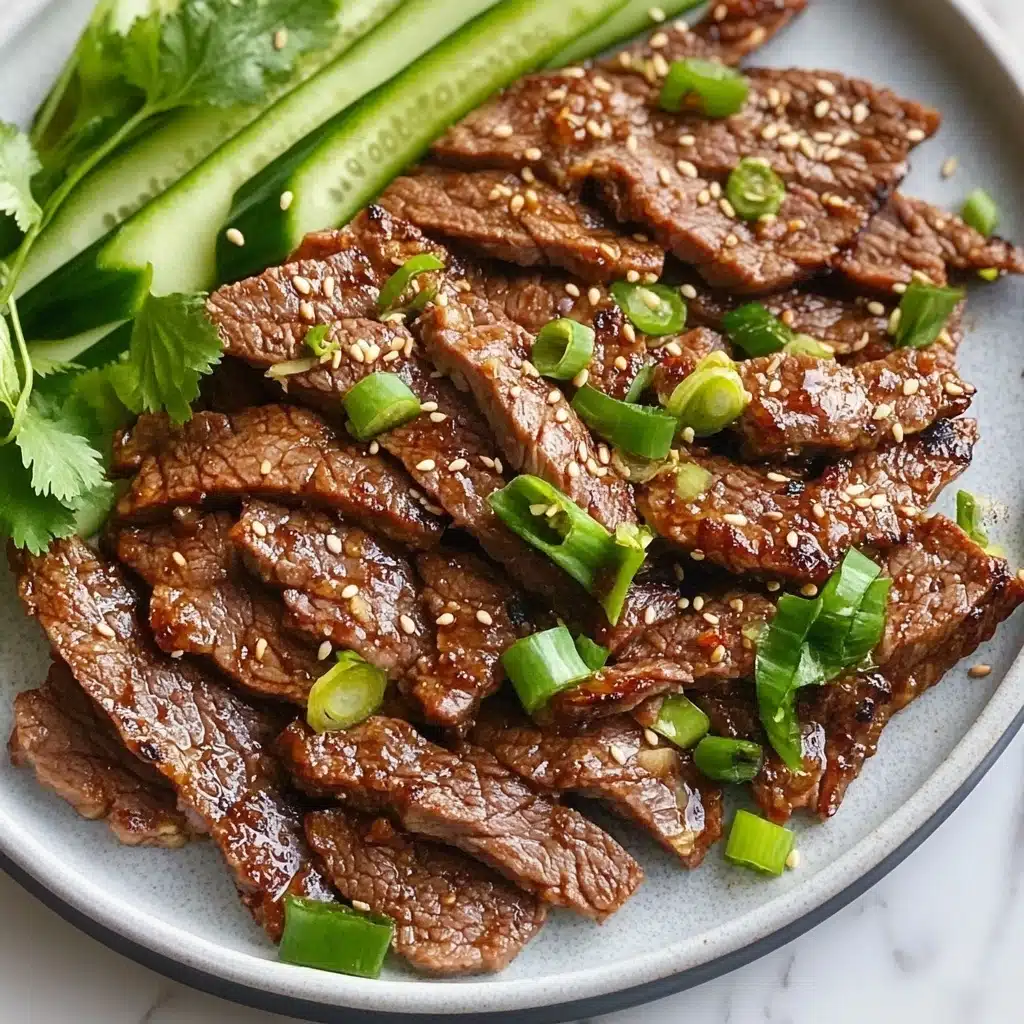
Garnishes
A flourish of thinly sliced green onions and a scatter of toasted sesame seeds is all you need for the authentic Korean Beef Bulgogi finish. For a little extra sparkle and freshness, consider a handful of fresh cilantro, slivers of red chili, or even an extra drizzle of toasted sesame oil just before serving.
Side Dishes
Bulgogi loves company—serve it with warm steamed rice, crisp lettuce leaves for wrapping, classic kimchi, or a medley of quick-pickled veggies. A side of sautéed spinach (sigeumchi namul) or simple cucumber salad balances the rich flavors perfectly.
Creative Ways to Present
Elevate your Korean Beef Bulgogi by making DIY lettuce wraps, piling it into fresh sliders, or topping a big, colorful bibimbap bowl. Try scattering it over fried rice, rolling into sushi hand rolls, or pairing with soft steamed buns for a super fun party platter.
Make Ahead and Storage
Storing Leftovers
Store any leftover bulgogi in an airtight container in the refrigerator—it’ll stay delicious for up to 3 days. The flavors actually deepen as it rests, making for an extra-flavorful lunch or dinner the next day.
Freezing
You can freeze cooked Korean Beef Bulgogi for up to 2 months—let it cool completely first, then seal tightly. If you want to plan ahead, you can even freeze the beef already marinated (before cooking), making busy weeknight meals even easier!
Reheating
Reheat gently in a skillet over medium heat, adding a splash of water or beef broth to keep it moist. If you’re in a hurry, a quick zap in the microwave works—just cover to prevent drying out, and stir halfway through for even heating.
FAQs
-
Do I really have to use rib eye steak for bulgogi?
Rib eye is the classic choice because it has great marbling and tenderness, but you can absolutely use sirloin or even flank steak if that’s what you have. Just remember to slice it very thinly and against the grain for best results.
-
What if I can’t find gochujang?
No worries! If gochujang isn’t available, try mixing a little sriracha or chili garlic sauce with a touch of miso or honey as a quick substitute. The flavor won’t be identical but you’ll get that lovely heat and sweet-savory depth.
-
Can I make Korean Beef Bulgogi on an outdoor grill?
Yes! Bulgogi is fantastic cooked over charcoal or gas—just be sure to use a grill basket or well-oiled grates for those thin slices, and cook quickly over high heat for that signature smoky char.
-
Is it okay to marinate the beef longer than 24 hours?
It’s best not to go much longer than overnight (about 12-24 hours) since the pear and soy sauce will continue to tenderize the meat—after too long, it can get mushy. If you’re short on time, even one hour will give good results.
Final Thoughts
If you’re hungry for a dish that blends savory, sweet, and just a touch of spicy magic, Korean Beef Bulgogi is truly a must-try. It’s simple, satisfying, and guaranteed to turn any meal into an occasion—so fire up your pan and treat yourself to a flavor-packed adventure at home. Let me know how it turns out!
Print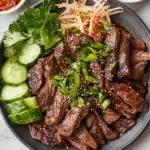
Korean Beef Bulgogi Recipe
- Prep Time: 2 hours
- Cook Time: 15 minutes
- Total Time: 3 hours
- Yield: 6 servings
- Category: Grilling
- Method: Stovetop
- Cuisine: Korean
Description
Enjoy the bold and savory flavors of Korean Beef Bulgogi with this easy-to-follow recipe. Tender rib eye steak slices are marinated in a flavorful blend of soy sauce, pear, garlic, and gochujang, then grilled to perfection. Serve with a sprinkle of sesame seeds and green onions for a delicious meal.
Ingredients
Marinade:
- 1 1/2 pounds boneless rib eye steak, thinly sliced
- 1/2 small pear, peeled and coarsely grated
- 1/4 cup reduced sodium soy sauce
- 2 tablespoons brown sugar
- 2 tablespoons toasted sesame oil
- 3 cloves garlic, minced
- 1 tablespoon freshly grated ginger
- 1 tablespoon gochujang, Korean red pepper paste
Additional:
- 2 tablespoons vegetable oil, divided
- 2 green onions, thinly sliced
- 1 teaspoon toasted sesame seeds
Instructions
- Prepare the Steak: Freeze the steak for 30 minutes, then slice thinly.
- Marinate the Steak: Combine pear, soy sauce, brown sugar, sesame oil, garlic, ginger, and gochujang. Marinate steak in the mixture for at least 2 hours.
- Grill the Steak: Heat vegetable oil in a grill pan. Cook the steak in batches until charred and cooked through.
- Serve: Garnish with green onions and sesame seeds before serving.
Notes
- If you don’t have a grill pan, a large skillet can be used as an alternative.
Nutrition
- Serving Size: 1 serving
- Calories: 380
- Sugar: 6g
- Sodium: 780mg
- Fat: 24g
- Saturated Fat: 8g
- Unsaturated Fat: 12g
- Trans Fat: 0g
- Carbohydrates: 10g
- Fiber: 1g
- Protein: 30g
- Cholesterol: 95mg

